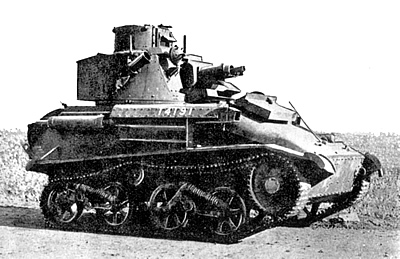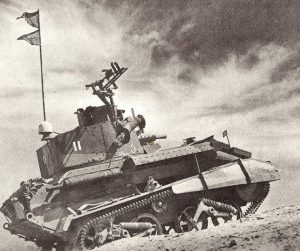
Last updated on February 18th, 2019 at 01:46 pm
The Mark VI light tank resembled the Mark V light tank. However, the Mark VI’s turret was redesigned to fit a radio.
Production of the Mark VI Light Tank series began in 1936. When World War II began, one thousand of these tanks were in service
The Mark VI formed a large part of the British tank force in Europe and North Africa in 1940. When the British Expeditionary Force (BEF) was in France, all of the divisional cavalry regiments and all the light tank regiments of the 1st Armoured Division used the Mark VI.

The Mark VI light tank encountered problems when it was used in the front lines during World War II. It was designed to be a reconnaissance tank, and did not have enough weapons or armor to be a match for German tanks, which had much better armor and much more powerful armament. The only weapons on the Mark VI light tank were machine guns, and the armor on the Mark VI was only 0.394 inches (10mm) thick.

In fact, when some of the Mark VI light tanks arrived in France to support the BEF, their machine guns were still in crates at sea, so the tanks had no guns at all. The only offensive weapons that the members of the tank crew had were their pistols.
Nevertheless, during the war, the Mark VI served with distinction in Greece, Malta, Crete, Syria and the Western Desert, where it played a role in the Siege of Tobruk, as well as in France.
Different versions of the Mark VI were produced, the primary ones being the Mark VIA and the Mark VIB.
In the Mark VIA, a single return roller was attached to the sides of the hull. This differed from the standard Mark VI, in which the roller was attached to the leading bogie. The Mark VIA also had an octagonal cupola with two lookouts.
Changes made to the Mark VIB were designed to make production easier. The two piece armored louver was changed to a one piece louver over the radiator. The octagonal cupola in the Mark VIA was changed to a circular one. The cupola had two glass lookouts.
Mark VIB Light Tank |
|
|---|---|
| Active: | 1937 |
| Crew: | 2 |
| Weight: | 5 tons (5,080kg) |
| Length: | 13ft 2in (4.01m) |
| Height: | 7ft 5in (2.26m) |
| Width: | 6ft 10in (2.08m) |
| Weapons: | Main – 1 x 0.5in (12.7mm) or 1 x 0.59 in (15mm) machinegun, Secondary – 1 x 0.303in (7.7mm) Vickers or 1 x 0.312in (7.92mm) Besa machinegun |
| Armor | Maximum – 0.394in (10mm) |
| Engine: | Meadows 6-cylinder gasoline, 88hp |
| Speed: | 34.78 mph (56kph) |
| Range: | 124.2 miles (200 km) |
